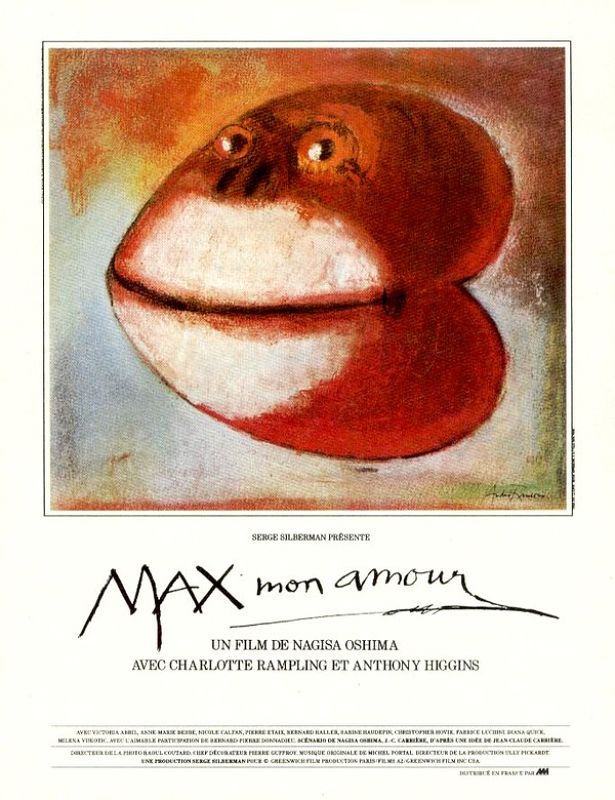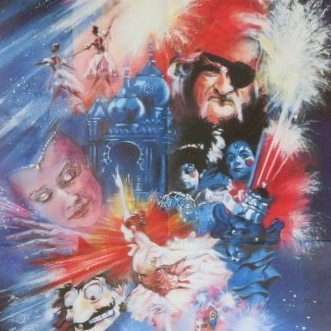Max, Mon Amour
Put your sexy paws on me, you damn dirty ape!

French poster | Acteurs Auteurs Associés
1986 — France / USA
A SERGE SILBERMAN production for GREENWICH FILM PRODUCTION S.A. PARIS, GREENWICH FILM U.S.A. and FILMS A2
Cast: CHARLOTTE RAMPLING and ANTHONY HIGGINS, with VICTORIA ABRIL, ANNE-MARIE BESSE, NICOLE CALFAN, PIERRE ÉTAIX, BERNARD HALLER, SABINE HAUDEPIN, CHRISTOPHER HOVIK, FABRICE LUCHINI, DIANA QUICK, MILENA VUKOTIC, and with the kind participation of BERNARD-PIERRE DONNADIEU
Director: NAGISA OSHIMA
Producer: SERGE SILBERMAN
Written by: NAGISA OSHIMA and JEAN-CLAUDE CARRIÈRE
Original story by: JEAN-CLAUDE CARRIÈRE
Editor: HÉLÈNE PLEMIANNIKOV
Cinematographer: RAOUL COUTARD
Production design: PIERRE GUFFROY
Costume design: BERNARD PERRIS
Special makeup effects designed by: RAY SCOTT
Music: MICHEL PORTAL
© Greenwich Film Production S.A. / Greenwich Film U.S.A., Inc.
In the 1980s, the French film industry had apparently decided that what English speaking audiences really wanted to see was celebrated actresses get freaky with things that they almost certainly shouldn’t. Is this true? Honestly, probably not, but the decade did give us both Possession (1981), which sees Isabelle Adjani play a woman cheating on her husband with some kind of writhing betentacled abomination unto God, and Max, mon Amour, which sees Charlotte Rampling cheating on her husband with some kind of ape… I mean, the non-human kind of ape. Technically all human intercourse is based around doing it with apes.
Yes, yes, this is the movie where Charlotte Rampling fucks a woman in an ape suit chimp!
Actually, we could draw more pointless parallels between Max and Possession. They’re both French produced English language films† directed and (co-)written by people who are neither… which are about married women with non-human lovers. Is there any significance to this fact? Eh, maybe. I don’t know what it would be and I’m not sure I can be bothered to ponder it all that much. I just thought it was interesting. I can’t say as the two have all that much in common overall.
Max, mon Amour (which hedges its bets in the opening credits, providing morphing the title into the English ‘Max, My Love’ during the title card) is the story of Margaret (Charlotte Rampling) and Peter (Anthony Higgins), a married couple. Peter is a British diplomat. Margaret is having an affair which she is hiding quite poorly. Surprisingly the film doesn’t beat around the bush by having him spend an entire act trying to find out who her lover is, instead just having him go to her love nest and ask directly within the first ten minutes. Margaret shares her super-secret flat with a chimpanzee, Max (played by a semi-uncredited‡ Ailsa Berk), with whom Peter finds her (maybe) postcoitus… well, except she says it’s fine for him to come into the bedroom, so… uh… yeah. He’s a bit miffed by the situation, would you believe? But, I mean, he has a bit on the side in his secretary, Camille (Diana Quick), and Margaret’s OK with that, so you know it’s cool, everything’s cool, he’s totally cool with it. In fact, he’s soooooooo cool with it that he suggests she moves Max into their actual house; it’ll save money on rent for the love nest. After all, they’re both sensible adults in mannered society, what could possibly go wrong? You may notice that the film opens with Peter cleaning a rifle. Mmm, Chekhovian. And so ensues a comedy of manners as we all try and keep up the façade of gentility.
So then… what to say about all that? Other than, like, ‘why’? Well, that I can’t tell you. I could probably manage a ‘how’ just about; the film was made by Greenwich Film Production, the company responsible for much of Luis Buñuel’s later work, with its producer and co-writer being a regular producer and a regular co-writer of Buñuel’s. Buñuel died in 1983; one ponders if this was originally conceived with him in mind. So instead you get Nagisa Oshima reasonably fresh off the success of Merry Christmas, Mr Lawrence (1983) and probably still wielding a fair bit of notoriety from In the Realm of the Senses (1976) (hell, that film still does), who seems at once both an odd and a rather reasonable choice. It stands as somewhat of an outlier in his oeuvre, not so much because of the content per se but for more aesthetic reasons; while all of Oshima’s theatrical films post-1976 (inclusive) were made with heavy European investment, this is the only film of his that eschews any sort of Japanese cultural setting, being set in Europe with an entirely European cast speaking European-ish. At the same time, it’s perhaps not entirely out of keeping; Oshima had an eye for social commentary and his works did get an increasing focus of sexuality, at least on a conceptual level, over time. Still, this was his last film for some thirteen years and his penultimate overall, and tends to be deemed a minor work that, according to people who know more about the man’s work than I do, barely feels like an Oshima film.
Well, that’s as maybe, but I think that I actually kind of love it. For all the weird sensationalism of the premise which very much invites controversy, the whole thing is actually a rather low-key affair. If you’re hoping, for some reason, to see Charlotte Rampling have saucy on-screen sex with a supposed ape, you’ll be sorely disappointed, I can tell you. She barely even gets naked. Hell, you only get to see one of her boobs! But, seriously, despite the much-touted premise, you get nothing like that. There’s not even much evidence to suggest that Mags and Max’s relationship is even sexual in nature; honestly, the question of ‘what exactly is the nature of their affair?’ is the driving one of the second act of the film, and both we and the film are richer for not really knowing. (Though IMDB’s trivia section alleges that there was meant to be a scene that confirms what’s going on at one point in the film’s development.) A large part of the plot is Higgins’ character going mad wondering just what it is his wife is getting up to behind closed doors; she’ll never tell, you know, that’d be gauche, but nonetheless she gives him the tools to resolve the situation if he really wants while having faith that he will be able to do the ‘right’ thing in the end. As such, it sticks to rather mild innuendo, it’d be uncouth to talk about it too frankly, would it not? As a result, the whole film ends up bizarre as they all try and talk about the elephant in the room without ever, you know, mentioning the elephant. The script is honestly pretty funny, as conversations end up taking odd turns which are presented in an utterly deadpan, matter-of-fact way as if they’re the discussing the weather or dinner plans.
I should probably talk a bit about the effects. The big one is obviously Max himself, who as mentioned earlier is performed by choreographer and puppeteer Ailsa Berk, seemingly off the strength of 1984’s Greystoke wherein she portrayed Tarzan’s ape foster mother. The marketing materials actually make quite a lot of the effects team’s association with that film. I suppose it makes sense. The ape costume is frankly one of the best I’ve seen in a film and Berk manages to carry herself in a convincing manner, though the eyes seem weird and there still feels like there’s something off about the proportions but it’s hard to say what exactly. I’d ordinarily say the legs, but chimpanzees do actually have fairly similar proportions to humans. Hmm. Still, given the subject matter (and, you know, general ethical questions regarding animal actors, and also that chimps are famously really fucking dangerous) it’s almost certainly the best option. Compare 1986’s other dirty ape movie, Link,* wherein the chimpanzee is played by an orangutan, because orangutans are less awful than chimps are. …Quite why they didn’t just tweak the script to make Link an orangutan instead is a question that nags at me. I digress; the fake ape is pretty decent. Less decent are the other effects, like a scene where Max is riding on the roof of a car on the autoroute which is hilariously bad. Still, such things aren’t really the point of the film: “the greatest ape romance since King Kong” apparently. (Which King Kong? They don’t specify.)
If only they didn’t keep using the work ‘monkey’ in lieu of ‘ape’.
† Well, I say that… actually a large portion of Max, mon Amour is actually in French. It makes sense, after all, they are in France, but there’s enough in English for it not to feel accurate to label it a ‘non-English language’ film in the tags.
‡ I mean, while she’s generally listed as uncredited online, she is given a prominent spot amidst the effects people (an ‘and’ credit where there would normally be no ‘and’ credit, oh, the excitement). It just never specifies that she’s Max… in the film. There’s a promotional spot for the film that explicitly reveals the great secret though, so they weren’t being that hush-hush about it.
* Yes, I know that’s not what
Link is about, but if there’s one scene people know from it, it’s the eponymous character leering at Elizabeth Shue in the shower.
At time of writing, I was unable to find Max, Mon Amour on any streaming service. It doesn't even have a JustWatch page. Sorry, kids. Alternatively, physical copies are reportedly available for rent via Cinema Paradiso.
The film has a 18 rating from the BBFC based solely having a 'bestiality theme'. As I say, it's actually incredibly tame, to the point where you can find reviews from its belated UK release lamenting that after all the hype it's just a giant tease! …Oh, no? Anyway, there's not all that much to get upset about. There's the brief bit of nudity from Charlotte Rampling as I say, and also Sabine Haudepin plays a prostitute and has herself a scene wherein she goes about topless (and wearing some skimpy knickers).



